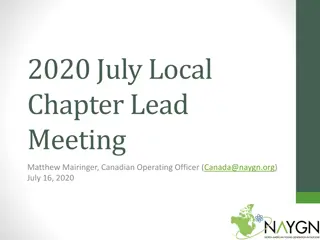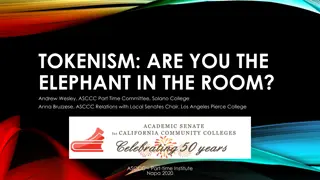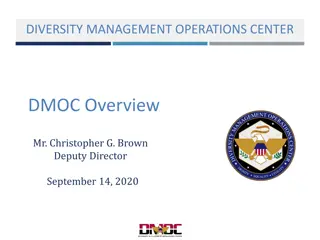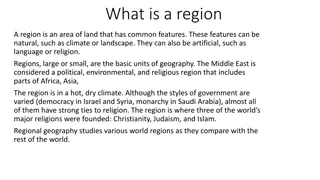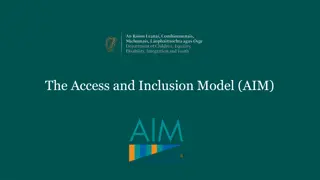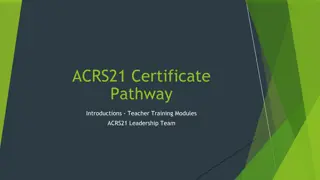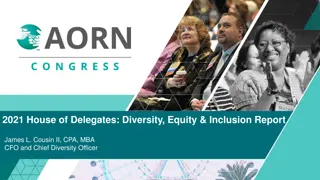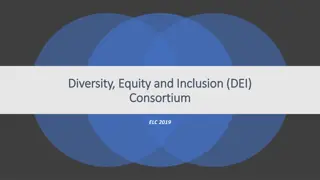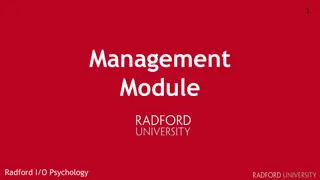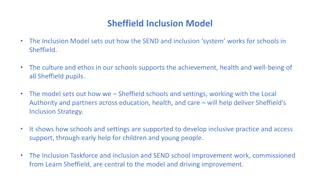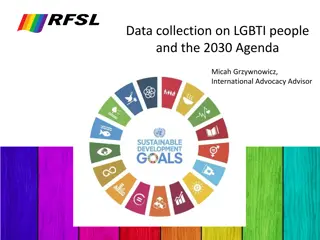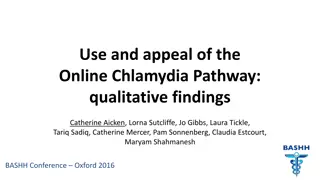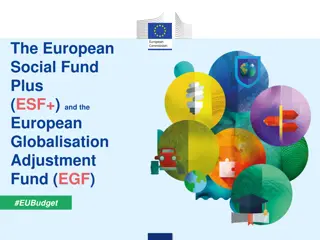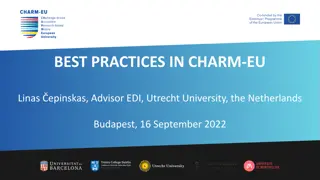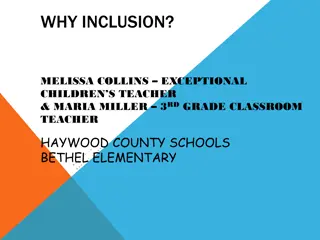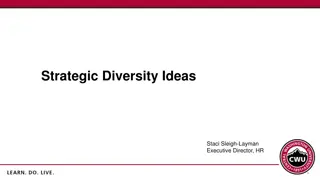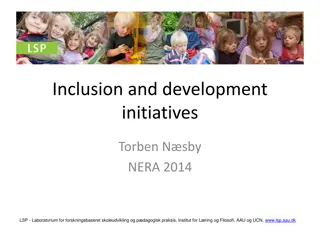On the Pathway from Diversity to Inclusion: The Role of Regions in European Context
The transition from diversity to inclusion in Europe involves political leaders coming together to address societal challenges. Cities and regions play a crucial role in responding to issues like climate change, job creation, migration, and community cohesion. Initiatives such as the Europe 2020 Strategy and Post-2020 Cohesion Policy aim for smart, sustainable, and inclusive growth with a focus on territorial impact and citizen engagement. Building inclusive societies requires promoting diversity as a strength, implementing smart policies for integration, and combating rising challenges like racism and discrimination. The goal is to create a society that values human rights, cultural diversity, social justice, and democratic participation.
Download Presentation

Please find below an Image/Link to download the presentation.
The content on the website is provided AS IS for your information and personal use only. It may not be sold, licensed, or shared on other websites without obtaining consent from the author. Download presentation by click this link. If you encounter any issues during the download, it is possible that the publisher has removed the file from their server.
E N D
Presentation Transcript
On the pathway from diversity to inclusion On the pathway from diversity to inclusion where do regions come in? where do regions come in?
European Context Political leaders must COME TOGETHER to make the needed changes in Europe Societal challenges of the 21stcentury climate change job creation community cohesion migration ageing society etc THINK LOCAL CITIES AND REGIONS are at the heart of responding
European Context Europe 2020 Strategy Post-2020 Cohesion Policy NEEDS SMART SUSTAINABLE INCLUSIVE GROWTH More TERRITORIAL IMPACT Europe closer to the CITIZEN HOW?
More TERRITORIAL IMPACT Europe closer to the CITIZEN finding answers to contemporary issues (ageing, migration) Stimulating employment in the knowledge economy Promoting economic growth through SMEs Boosting renewable energy resources Developing circular economy Developing physical and digital connectivity Improving the quality of life through services ESPON European Territorial Review The best way to reconnect EU with people is civil dialogue. (Kelig Puyet, Director of Social Platform) - communicate with citizens in cities and regions, listen to their concerns, proposals and expectations Guarantee EQUALITY, JUSTICE, NON- DISCRIMINATION - values and constitutional principles of the European society Build INCLUSIVE SOCIETIES
DIVERSITY A reality of European life - culture, traditions, heritages, outlooks DIVERSITY IS A STRENGTH ! BUILD INCLUSIVE SOCIETIES ! OPPORTUNITIES Implement smart policies to foster integration Promote mutual understanding and respect FIND THE ADVANTAGES IN DIVERSITY! CHALLENGES Current rise in racism, intolerance, discrimination, hate speech, xenophobic expression, social fragmentation, mistrust THREATS To democratic security Tension, violence, instability
The aim of SOCIAL INTEGRATION is to create a SOCIETY FOR ALL, in which every individual, each with rights and responsibilities, has an active role to play. Such an inclusive society must be based on respect for all human rights and fundamental freedoms, cultural and religious diversity, social justice and the special needs of vulnerable and disadvantaged groups, democratic participation and the rule of law. The Action Plan on Building Inclusive Societies (2016-2019) 1. Education 2. Combating intolerance and discrimination 3. Support for effective integration policies
Diversity of cultural backgrounds and associated differences in skills, education and abilities a rich resource for companies and creative teams but also for the social and economic development of societies Take into account the historic differences in Europe - differing diversities ! In the European context we need to acknowledge the very different circumstances in which national societies emerged and developed in northern, western, eastern and southern Europe. For example, in contrast to the northern and western part of Europe, which had relatively homogeneous dominant national cultures over an extended period of time and was later associated with post-colonial migration, the east European societies emerged out of the imperial Austro-Hungarian, Ottoman and Russian legacy and changing borders, characterised by a rich cultural diversity with numerous ethic and religious minorities.
Intercultural integration based on : Protection of minority cultures Intercultural education Fight against racism and xenophobia Prevention of hate speech Fostering culture tolerance Cities are considered the front line of integration and diversity management, also known as laboratories for policy innovation and social cohesion.
Models for management of cultural diversity Should immigrants/minorities keep the cultures of their countries of origin ? MODELS Yes No Should immigrants/minorities absorb the culture of the (host) majority ? Yes INTEGRATION ASSIMILATION No SEGREGATION EXCLUSION Source: High Commissioner for Immigration and Intercultural Dialogue (ACIDI), Portugal, 2013
Cities and Regions for Integration Initiative In the context of migration pressure nowadays, the successful integration of migrants and refugees is of great importance for an EU that wants to strengthen social cohesion and promote democratic values. Political platform for sharing relevant information and promote diversity as an added value to building inclusive cities and ensuring social cohesion. The mission is to support the integration of migrants and refugees on behalf of regions and communities of all sizes; encourage cooperation between smaller localities, cities and regions; to contribute to presenting a stronger narrative of solidarity and countering disinformation in this field. Join at: https://ec.europa.eu/eusurvey/runner/IntegrationInitiative
MIGRATION part of the globalized world we live in today priority for European regions, municipalities and cities. pressure especially on the subnational levels to promote integration and contribute to social, economic and civic inclusion requires adequate policies and funding from national governments and EU COOPERATION IS NEEDED!
Different levels of migration Intra-regional and national migration = when people move to urban centers within the same region or country - Human capital migrates from (remote) rural areas to urban and accessible rural locations. Intra-European migration = European citizens move to another country looking for better work and living conditions -> EFFECTS: Brain drain, population decline, changing demographic profiles, declining economical activities, increasing challenges to provide services of general interest; shrinking regions Extra-European migration = European citizens moving outside Europe in search of better prospect; people moving to Europe from non-European countries Extra-European immigration = a large number of people from other continents that migrate to Europe, seeing it as a continent of better prospects. ESPON European Territorial Review
WHY COOPERATING Reducing pressure on urban areas from intra-regional and domestic migration Better integration of intra-European immigrants Better integration of migrants Improved management of refugee flows According to the type of migration, different joint action is needed! ESPON European Territorial Review
EU funded cooperation project AMiD (Access to services for Migrants with Disabilities)aims to support an efficient management of the reception and integration of asylum seekers and migrants with disabilities in the EU. The impact of culture on refugees relocation is also taken into account. The lack of tool and procedures to support refugees and asylum seekers with disabilities with the right actions and services is the challenge that AMiD wants to face. The project will result in the creation of a specific Needs Assessment Tool to be circulated among all actors involved in the welcome of migrants. The tool will empower Local Authorities, NGO-Non Governmental Organisations and EU agencies to assess and support with adequate responses migrants and refugees with disabilities, hopefully serving as a foundation for launching a common EU approach to this topic. It will facilitate the systematisation of a common approach for migrants and refugees with disabilities.
AER is an important partner in the consortium, representing local authorities. 3 AER member regions have an active role in the Community Advisory Board Timis, V rmland and Valencia. Community-Advisory Board represents the different stages of the assistance to migrants: from the first contact to the reallocation in other EU member states, while the 3 AER members are the voice of local authorities in the CAB. The Community Advisory Board aims to develop a permanent task-force able to coordinate future common actions together with EU Agencies, inspiring a common European Union approach and strengthening important aspects of the Common European Asylum System. Integration Fund programme under grant agreement No 776055 This project has received funding from the European Union s AMIF Asylum Migration and
Migrant Integration Governance in Romania Romania - a country of emigration: departures are larger than arrivals and the presence of foreigners in the country is limited. Official statistics show no major fluctuations in the recent years but a steady increase in the number of third country nationals was observed between in 2013 and 2016, mostly from Moldova, Turkey, China. Integration Strategy Romania does not have a separate Integration Strategy but the following objectives regarding the integration of non-nationals are included in the National Strategy for Immigration : foster the social integration of immigrants and refugees create an environment to facilitate the integration of 3rd country nationals. include of integration aspects in all other relevant policy areas The implementation of the National Strategy on Immigration is described in annual Action Plans - focused on improving refugees access to their fundamental rights and improve integration through continued assistance on the 4 main pillars: social, medical, housing and employment.
Migrant Integration Governance in Romania Integration Programme - a series of services offered through a cooperative effort between public institutions, local communities non-governmental organisations and other stake-holders, under the coordination of the General Inspectorate for Immigration. All aim to facilitate the integration of beneficiaries of international or subsidiary protection in the Romanian society. The programme consists of counselling services and support activities ensuring access to the following rights: employment, housing, medical and social assistance, social security and education. It also includes cultural adaptation activities, language courses, civic education, vocational training and labour market assistance. The Programme generally lasts 6 months and enrolment needs to take place within 30 days from the granting of protection. It is not mandatory, but participation offers benefits such as a non-reimbursable financial aid.
EU funded project Migrant in Intercultural Romania was meant to continue the development of the mechanism of consultation with third country national communities started in 2008 through the project Social Integration and Cohesion for Third Country Nationals and continued in the following years through the projects Migrant in Romania and Intercultural Romania. Starting with August 2012, the activities aiming to support the civic participation and integration of migrants were developed for three years, within a project co-financed through the European Fund for the Integration of third country nationals, administered in Romania . MAIN GOAL: The main goal of the project was to contribute to the promotion of cohesion and integration, on the basis of the principles of a participatory inclusive democracy, to enhance consultation and civic participation of migrants. A consultancy mechanism among migrants, public institutions and civil society organizations has been developed.
Migrant Integration Governance in Timis County, Romania As opposed to the general trend in Romania, TIMIS COUNTY, as the most economically developed centre (after the capital), is a destination county - national migration towards Timis and extra-European immigration! The Asylum Centre in Timisoara, one of the 6 Regional Centers for Accommodation and Procedures for Asylum Seekers in Romania, has the responsibility of managing asylum cases and refugee integration. Once granted protection in Romania, all refugees are included in an integration programme, developed and supervised by the General Inspectorate of Immigration, operated by an integration officer.
Timis County Part of Banat Region a historical example of inclusion through culture Home of multiethnic groups, living in harmony for ages Timisoara, its capital city is synonym with multiculturality Timisoara hosts 17 Foreign Consulates Timisoara European Capital of Culture 2021
Timis County Council The public administration responsible for designing and implementing strategies and programs for economic, social and environmental development of the county, based on the proposals received from the local councils. It also ensures the necessary framework for the provision of public services of county interest regarding: social services for the protection of the child, the disabled, the elderly, the family and other vulnerable groups. The General Directorate of Social Assistance and Child Protection Timis is the public institution of county interest, subordinated to the County Council Timis, which offers, at county level, the means of social assistance in the field of protecting the above mentioned vulnerable groups. The institution has the responsibility to develop and diversify the specialized social services, according to the identified needs, with the priority aim of maintaining the social functionality of the person. The mission of the institution is: To ensure the promotion, coordination, monitoring and control of the activity of protection of the rights of the child, single persons, elderly persons, persons with disabilities and any persons in difficulty.
GTR- Generaia tnr romn ( Young Romanian Generation) - non-governmental, non-political, non-religious and non-profit NGO. GTR was founded in 2001, currently with representatives or branches in all main cities of Romania. Goals: Prevention of human trafficking, providing psychological and medical assistance to victims and also developing programs for reintegration and re-socialization of victims of human being trafficking. The issues the NGO deals with: Human trafiking Refugee shelter and accomodation Discrimination regarding roma people Unaccompanied minors Among partners of GTR: United Nations High Commissioner for Refugees United Nations Office at Geneva French Immigration Office
Romanian Arab Cultural Centre It was created in 2008, prompted by the local need in Timisoara for an association supporting the integration of migrants from Arab countries and also assisting the Romanian community integrating these migrants through a variety of activities. It promotes the understanding of the Arab and Muslim cultural values. It organises annual multi- cultural events and festivals.
Conclusions? Recommendations for improving policies, creating more inclusive societies?
Thank you for your kind attention! Mihai RITIVOIU mihai@cortez.ro President Committee 2 for Social Policy and Public Health ASSEMBLY OF EUROPEAN REGIONS County Councillor Timis County Council TIMISCOUNTY - ROMANIA


